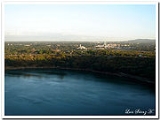
Tiscapa Lagoon Natural Reserve
Encyclopedia
Tiscapa Lagoon Natural Reserve (Spanish: Reserva Natural Laguna de Tiscapa) is a lagoon
of volcanic origin that formed over 10,000 years ago. It is located in the capital city of Managua
in Nicaragua
. Tiscapa Lagoon was declared a protected area
as a natural reserve on October 31, 1991. The reserve is managed by the Ministry of the Environment and Natural Resources (MARENA) and compromises one of 78 protected areas of Nicaragua.
The reserve is located within city limits of the capital, Managua, and is a popular tourist attraction. Restaurants and stores line the walls of the lagoon. Canopy rides provide a panoramic view of the old downtown where only a few buildings survived the 1972 earthquake
that destroyed 90% of the capital city, however, many new buildings and shopping malls have been built since then. Many pre-Columbian artifacts have been found in and around lagoon and reserve.
Its unique ecosystem, with its own characteristic flora and fauna and height, you are given a privileged view of Managua (see virtual tour of the sights of Tiscapa HERE), which observes the most representative buildings in Managua.
Lagoon
A lagoon is a body of shallow sea water or brackish water separated from the sea by some form of barrier. The EU's habitat directive defines lagoons as "expanses of shallow coastal salt water, of varying salinity or water volume, wholly or partially separated from the sea by sand banks or shingle,...
of volcanic origin that formed over 10,000 years ago. It is located in the capital city of Managua
Managua
Managua is the capital city of Nicaragua as well as the department and municipality by the same name. It is the largest city in Nicaragua in terms of population and geographic size. Located on the southwestern shore of Lake Xolotlán or Lake Managua, the city was declared the national capital in...
in Nicaragua
Nicaragua
Nicaragua is the largest country in the Central American American isthmus, bordered by Honduras to the north and Costa Rica to the south. The country is situated between 11 and 14 degrees north of the Equator in the Northern Hemisphere, which places it entirely within the tropics. The Pacific Ocean...
. Tiscapa Lagoon was declared a protected area
Protected area
Protected areas are locations which receive protection because of their recognised natural, ecological and/or cultural values. There are several kinds of protected areas, which vary by level of protection depending on the enabling laws of each country or the regulations of the international...
as a natural reserve on October 31, 1991. The reserve is managed by the Ministry of the Environment and Natural Resources (MARENA) and compromises one of 78 protected areas of Nicaragua.
The reserve is located within city limits of the capital, Managua, and is a popular tourist attraction. Restaurants and stores line the walls of the lagoon. Canopy rides provide a panoramic view of the old downtown where only a few buildings survived the 1972 earthquake
1972 Nicaragua earthquake
The 1972 Nicaragua earthquake was an earthquake that occurred at 12:29 a.m. local time on Saturday, December 23, 1972 near Managua, the capital of Nicaragua. It had a magnitude of 6.2 and occurred at a depth of about 5 kilometers beneath the centre of the city. Within an hour after the main...
that destroyed 90% of the capital city, however, many new buildings and shopping malls have been built since then. Many pre-Columbian artifacts have been found in and around lagoon and reserve.
Its unique ecosystem, with its own characteristic flora and fauna and height, you are given a privileged view of Managua (see virtual tour of the sights of Tiscapa HERE), which observes the most representative buildings in Managua.

